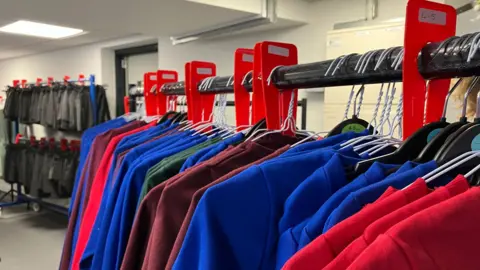In a significant development affecting educational policies in England, proposed changes to the school uniform regulations are set to influence over four million students. This initiative is part of the broader Children’s Wellbeing and Schools Bill, which is currently navigating various parliamentary stages before it can become law. The Department for Education (DfE) has articulated that these changes will require approximately 70% of secondary schools and 35% of primary schools to limit compulsory branded items to three—plus a branded tie for secondary school pupils.
The government’s rationale behind these changes is to alleviate the financial burden on families, with estimates suggesting that the average cost for a full secondary school uniform and accompanying PE kit currently stands at £442, while primary school pupils incur costs averaging £343. These figures highlight the considerable expenses that parents face in ensuring their children comply with school uniform policies. Previous g ide critiques of uniform policies have also emphasized affordability, noting the need for schools to strike a balance that does not complicate the decision-making process for parents selecting educational institutions for their children.
The intended implementation date for these regulated uniform measures is September 2026, with the government projecting potential savings of around £50 per child. However, this perspective is met with skepticism from uniform retailers who warn that the mandated changes could inadvertently lead to increased costs for families. They argue that if schools switch to lower-quality generic uniforms, parents might find themselves having to replace these garments more frequently than branded options, ultimately resulting in greater financial strain. The Schoolwear Association, representing manufacturers, has expressed concerns that branded uniforms play a critical role in reducing inequality among students, emphasizing their importance in promoting uniformity and improving student behavior.
In the current landscape, many parents turn to uniform exchanges as a viable solution to secure the necessary items for their children’s schooling. An example of this initiative is located in Darlington, where the local council runs a uniform exchange that allows parents to obtain donated items for free, effectively supporting those from over 25 different schools in the vicinity. This program has been operational for five years and has distributed approximately 12,000 items to around 4,000 families. Commenting on the efficacy of these exchanges, volunteers have expressed their concerns that despite the new government regulations, strict uniform policies will continue to pose challenges to affordability for many families.
One parent shared their mounting worries regarding the financial implications as their children transition from primary to secondary schooling. Struggling with the heightened expectations for specific styles, colors, and suppliers, this parent underscored how quickly the expenses multiply. Another perspective is shared by Matt Perry, head teacher at The Halifax Academy in West Yorkshire, who underscores the importance of maintaining uniform standards while being flexible enough to accommodate financial constraints faced by families. His school has opted to provide ties free of charge and maintains a policy where only certain essential items are required to include branding.
It is essential to recognize that the implications of such uniform policies extend beyond mere compliance and aesthetics; they play a crucial role in fostering a sense of inclusion and pride among students. Mr. Perry advocates for understanding the dynamics of family situations and recognizing that sometimes adherence to strict policies can hinder attendance, thus reinforcing the need for flexibility.
As the Children’s Wellbeing and Schools Bill progresses towards its impending readings in the House of Lords, the importance of equitable education and socioeconomic factors becomes increasingly clear. The proposed changes aim not only to enhance the financial landscape of school uniform policies but also to support the social fabric within schools, ensuring that children’s educational experiences are nurtured in a manner that accommodates the diverse realities of their families. This holistic approach could mark a significant step forward in transforming the educational experience for millions of students across England.



